Our Ocean’s Dire Message
The world’s Oceans are the hottest they have been in recorded history, and by a wide margin. A human-driven climate crisis is to blame. From the Atlantic to the Pacific to Antarctica, record water temperatures are forcing scientists to grapple with how global heating is warming the oceans, often in unpredictable and extreme ways, and with implications for the entire planet. Hawaii’s ocean thermal shield is not exempt from these global climate changes.
The average temperature of the world’s oceans spiked to 70 degrees Fahrenheit in April, the highest readings since records began.
The following NOAA graph demonstrates just how much the daily average of sea surface temperatures are now historically out of synch. The light gray lines represent each corresponding year’s ocean surface temperatures, while the dotted dark gray line represents temperature the average from 1991-2020 and the blue line is this current year rise in temperature.
Some of this year’s warmth can be attributed to El Niño, a natural climate pattern that began in July and is linked to marine heat waves. But the underlying cause of the heat is human-driven global warming.
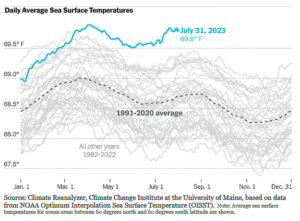
It’s hot all over the world right now, with record heat waves searing three continents during July, which was Earth’s hottest month in recorded history. But it’s not just the current high temperatures on land that are making the oceans so hot.
Sea surface temperatures have been rising since at least the early 20th century, when humans began pumping many more greenhouse gases like carbon dioxide into the atmosphere.
Oceans have absorbed almost all of the greenhouse gases (primarily CO2) from human-driven activity, which are now fueling the planetary heat-up.
…see in the graphic below:
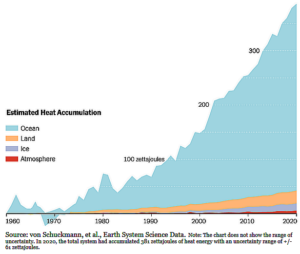
Water has a much higher heat capacity than land, meaning it can absorb large amounts of energy with only a slight increase in temperature. But after many decades of cumulative heat, we’re now starting to see a big shift.
Gregory Johnson, an oceanographer at the National Oceanic and Atmospheric Administration, called this year’s temperatures “astonishing.” The oceans have “been doing us a big service by delaying global warming considerably,” he told Elena, “but it comes at a cost.”
Cause and effect
As oceans store more heat, they expand, contributing to sea level rise. Warmer ocean temperatures also provide more fuel for tropical cyclones and other extreme weather events which Hawaii remains ill-prepared to address. Much of the recent increase in ocean temperatures is shocking, but not unexpected, according to climate data projections and previous scientific forecasts.
It bears repeating — if we continue to pump greenhouse gases into the atmosphere at roughly our current rate, which is likely, the world’s oceans will continue to heat up unabated with escalating consequences. July’s global average sea surface temperature falls within that expected range, though at the higher end of the temperature projections in the following graph:
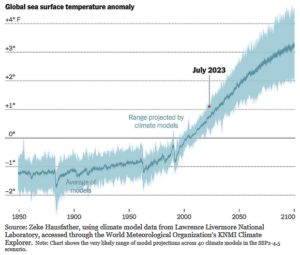
Alarm Bells Are Ringing All Over the World
Last month, a buoy off the coast of Florida recorded a stunning reading of 101.1 degrees Fahrenheit, or just over 38 Celsius, a possible world record. And those temperatures are having an immediate and deadly effect on one of the world’s must crucial ecosystems. An increase in temperature between one or two degrees Celsius over several weeks can force corals to expel the algae living in their tissues. The algae are what makes corals colorful, so this process is called bleaching. Algae are also the main source of energy for corals. If temperatures remain high and algae doesn’t return, the corals die.
Approximately 44% of the global ocean recently experienced marine heat waves, according to the US National Oceanic and Atmospheric Administration.
Extreme water temperatures are responsible for coral bleaching and harmful algal blooms, among other impacts. One of the most notorious marine heat waves, known as “The Blob,” hit waters off North America’s west coast in the mid-2010s, decimating populations of Pacific cod, seabirds and salmon.
Marine mitigation efforts shoveling sand against an incoming tide
Between 2016 and 2017, an enormous bleaching event caused the Great Barrier Reef, the largest living structure on Earth, to lose half of its corals, at the same time, Hawaii’s prized island reef systems suffered significant coral die-off in 2016 from Hawaii Island to Kauai and beyond. A quarter of all marine life depends on corals. Many of these species are a major source of food for millions of people, especially in poor countries. Corals also protect coasts from sea level rise, support tourism industries around the world and serve as an early warning system for other marine life.
Researchers are studying how some species are migrating to cooler environments. They’re also trying to find corals that can withstand heat stress so they can one day create tougher reefs. However, the best attempts to rehabilitate corals have met considerable obstacles and limited success as ocean temperatures continue to rise.
A key system of ocean currents could collapse this century
Scientific investigations are revealing just how quickly things are changing in the oceans.
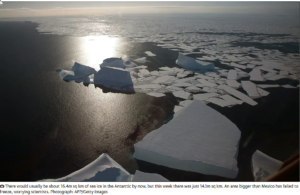 A new study shows an ancient ice sheet retreated at a startling 2,000 feet per day, shedding light on how quickly ice in Antarctica could melt and raise global sea levels in today’s warming world.
A new study shows an ancient ice sheet retreated at a startling 2,000 feet per day, shedding light on how quickly ice in Antarctica could melt and raise global sea levels in today’s warming world.In the past, one of the fastest retreat rates detected for a glacier was at Pope Glacier in West Antarctica, a smaller glacier that’s very close to the enormous Thwaites Glacier, nicknamed the “doomsday glacier” because of its relatively large melting contribution to sea level rise. During a period in 2017, based on satellite calculations, Pope Glacier retreated at a speed of about 105 feet (32 meters) per day. That’s quite fast — but still nothing like the rates of as much as 2,000 feet per day, the study found for the Eurasian ice sheet.
By Sea and by Land, We Are Cooking the Planet, and Ourselves with it
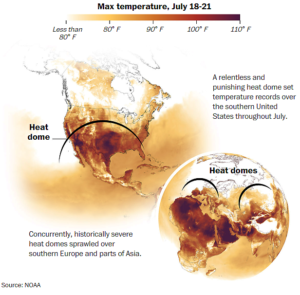 A rash of intense heat domes — zones of high pressure sprawled across the northern hemisphere — plagued Asia, southern Europe and northern Africa, North America and much of the tropics including the Caribbean. Extreme heat was even observed on several occasions across the southern hemisphere, where it is the middle of winter.
A rash of intense heat domes — zones of high pressure sprawled across the northern hemisphere — plagued Asia, southern Europe and northern Africa, North America and much of the tropics including the Caribbean. Extreme heat was even observed on several occasions across the southern hemisphere, where it is the middle of winter.China registered an all-time high temperature for the country of 126 degrees (52.2 degrees Celsius), while the July 16 high of 128 degrees (53.3 Celsius) in Death Valley, Calif., was two degrees shy of the highest reliably measured temperature on Earth. Numerous countries surpassed 122 degrees (50 Celsius) for highs. In the Middle East, the heat index reached 152 degrees (66.7 Celsius), near the limit of human survival.
In some cases, daily heat records have been strung together into record-long streaks, including 31 straight days reaching 110 degrees (43.3 Celsius) or higher in Phoenix, 44 days at or above 100 degrees (37.8 Celsius) in El Paso and 46 straight days with a heat index over 100 degrees (37.8 Celsius) in Miami.
July is typically the hottest month of the year in the northern hemisphere. Add in a developing El Niño, the cyclical warming of the tropical Pacific Ocean that adds heat to the atmosphere, temperatures leaped to new heights in many areas. Furthermore, human-caused climate change is making heat waves more frequent, intense, larger and longer-lasting.



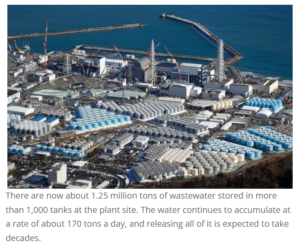 The implied Tepco argument and focus has been on the release of cesium-137 and its 30 year toxic lifespan into the marine ecosystem and food chain. The utility argues that its radioactive waste dumping activities are benign to the environment (meaning people, fish, and the marine ecosystem).
The implied Tepco argument and focus has been on the release of cesium-137 and its 30 year toxic lifespan into the marine ecosystem and food chain. The utility argues that its radioactive waste dumping activities are benign to the environment (meaning people, fish, and the marine ecosystem).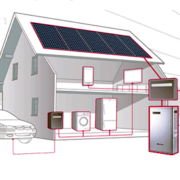
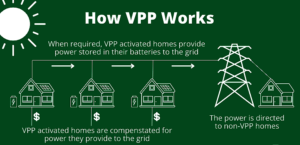 A Virtual Power Plant (VPP) is defined as a network of decentralized, medium-scale power generating units featuring flexible power options for consumer-sited storage and solar power generation systems.
A Virtual Power Plant (VPP) is defined as a network of decentralized, medium-scale power generating units featuring flexible power options for consumer-sited storage and solar power generation systems.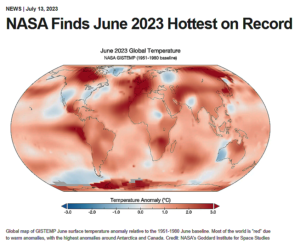 Electricity production (25% of 2021 greenhouse gas emissions) – Electric power generates the second largest share of greenhouse gas emissions and includes emissions from electricity production used by other end use sectors (e.g. industry). This 2021 NASA report total does not reflect the coming shift in energy demand off fossil fuels and to electricity energy consumed to support the coming electrification of most ground transportation.
Electricity production (25% of 2021 greenhouse gas emissions) – Electric power generates the second largest share of greenhouse gas emissions and includes emissions from electricity production used by other end use sectors (e.g. industry). This 2021 NASA report total does not reflect the coming shift in energy demand off fossil fuels and to electricity energy consumed to support the coming electrification of most ground transportation.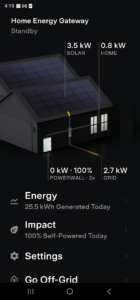 VPP home and community systems are the next generation in clean energy self-sufficiency and lower cost energy reliability, by introducing battery storage in combination with rooftop solar. And battery storage are projected to include electric vehicles serving more than just transportation needs, ad energy security for home owners in the form of a battery back-up system for the home with wheels.
VPP home and community systems are the next generation in clean energy self-sufficiency and lower cost energy reliability, by introducing battery storage in combination with rooftop solar. And battery storage are projected to include electric vehicles serving more than just transportation needs, ad energy security for home owners in the form of a battery back-up system for the home with wheels.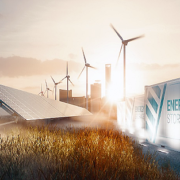
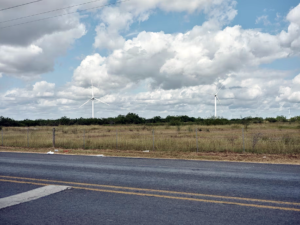 The poster boy for this disconnection between blanket support for fossil fuels and blocking the advancement of renewable energy as national policy has been Texas. A classic example of of don’t do what I do, do what I say. Like other southern states, Texas is is battling brutal climate-fueled heat waves now regularly reaching triple-digit temperatures. This summer, like last summer, global heat waves triggered
The poster boy for this disconnection between blanket support for fossil fuels and blocking the advancement of renewable energy as national policy has been Texas. A classic example of of don’t do what I do, do what I say. Like other southern states, Texas is is battling brutal climate-fueled heat waves now regularly reaching triple-digit temperatures. This summer, like last summer, global heat waves triggered 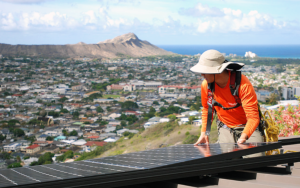 For the past 10 years, the utility’s transition decisions to renewable energy have been notable, not so much in terms of actions, but in overall inaction. The system has historically worked well, for the most part, but time, technology, and necessity have turned obsolete utility operating assumptions on their head.
For the past 10 years, the utility’s transition decisions to renewable energy have been notable, not so much in terms of actions, but in overall inaction. The system has historically worked well, for the most part, but time, technology, and necessity have turned obsolete utility operating assumptions on their head.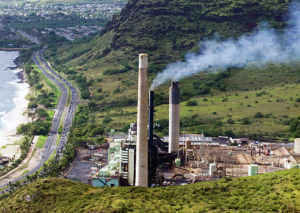 The utility’s focus on preserving its past stranglehold on electricity production and delivery is already endangered as an increasing number of households and businesses who are taking control of their energy destiny by adopting rooftop solar and battery storage. This consumer trend is driven by several factors beyond cost and energy savings, increasing energy security is a major factor in this transition, reducing grid power essentially to a backup energy source. Efficiency is another major factor favoring this cost-saving and energy-resiliency move by consumers.
The utility’s focus on preserving its past stranglehold on electricity production and delivery is already endangered as an increasing number of households and businesses who are taking control of their energy destiny by adopting rooftop solar and battery storage. This consumer trend is driven by several factors beyond cost and energy savings, increasing energy security is a major factor in this transition, reducing grid power essentially to a backup energy source. Efficiency is another major factor favoring this cost-saving and energy-resiliency move by consumers. In Hawaiian Electric’s own words… “In 2022, solar power provided about 17% of Hawaii’s total electricity, primarily from small-scale, customer-sited solar power generation that is the 10th-highest among the states.”
In Hawaiian Electric’s own words… “In 2022, solar power provided about 17% of Hawaii’s total electricity, primarily from small-scale, customer-sited solar power generation that is the 10th-highest among the states.” 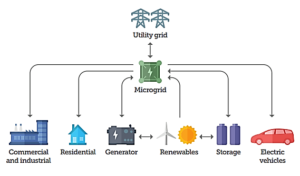
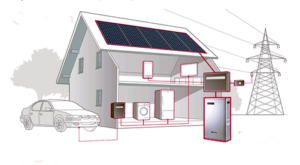 In the case of grid-connected battery systems, they manage real-time power demands, while simultaneously balancing power supply with demand between the microgrid and the utility grid and in the combination of managing one-way and two-way directional power flows. In effect these points of power production and consumption (as in individual buildings) can operate entirely independent or as part of the utility grid
In the case of grid-connected battery systems, they manage real-time power demands, while simultaneously balancing power supply with demand between the microgrid and the utility grid and in the combination of managing one-way and two-way directional power flows. In effect these points of power production and consumption (as in individual buildings) can operate entirely independent or as part of the utility grid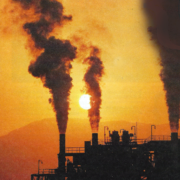

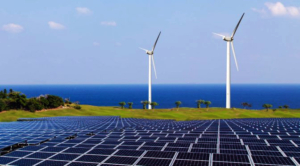 If we continue, as state energy policy, to promote energy outcomes in support of 20th century polluting energy options, then we do it at the public expense. Expense that is measured in missed opportunity for a lower cost statewide transformation to a sustainable and self-sufficient clean-energy economy. Time is no longer on our side, and repeating lessons already learned is no longer an economic or political option.
If we continue, as state energy policy, to promote energy outcomes in support of 20th century polluting energy options, then we do it at the public expense. Expense that is measured in missed opportunity for a lower cost statewide transformation to a sustainable and self-sufficient clean-energy economy. Time is no longer on our side, and repeating lessons already learned is no longer an economic or political option.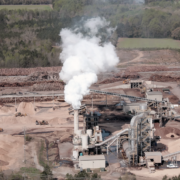
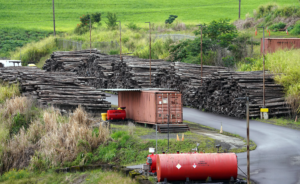 The Hawaii Supreme Court struck down the appeal by Hu Honua regarding PUC denial of their proposed power purchase agreement.
The Hawaii Supreme Court struck down the appeal by Hu Honua regarding PUC denial of their proposed power purchase agreement.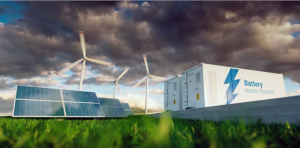 Hu Honua, for instance, has been proposed for hydrogen generation but would need PUC approval. With this Supreme Court decision, that will not happen. Burning trees to split water and make hydrogen certainly isn’t green and isn’t cost-competitive because the energy required is too expensive and very inefficient.
Hu Honua, for instance, has been proposed for hydrogen generation but would need PUC approval. With this Supreme Court decision, that will not happen. Burning trees to split water and make hydrogen certainly isn’t green and isn’t cost-competitive because the energy required is too expensive and very inefficient.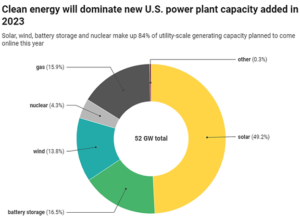

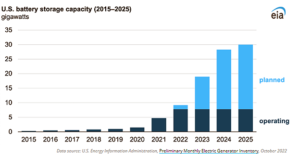 Although macroeconomic and supply chain issues influence costs, the overall cost of PV solar and battery storage continues to drop with technology and manufacturing improvements. and efficiency advancements. New energy projects pairing solar with battery storage are being built across the nation. A number of them are located in Hawaii, and more are being planned.
Although macroeconomic and supply chain issues influence costs, the overall cost of PV solar and battery storage continues to drop with technology and manufacturing improvements. and efficiency advancements. New energy projects pairing solar with battery storage are being built across the nation. A number of them are located in Hawaii, and more are being planned. Hawaii is by no means standing still when it comes to clean and renewable energy. Hawaii’s 100% renewable mandate by 2045 for energy powering the state’s two utilities may be a ways out, but challenges remain on the road to Hawaii’s 21st century clean energy economy. The good news is as a state we are moving forward.
Hawaii is by no means standing still when it comes to clean and renewable energy. Hawaii’s 100% renewable mandate by 2045 for energy powering the state’s two utilities may be a ways out, but challenges remain on the road to Hawaii’s 21st century clean energy economy. The good news is as a state we are moving forward.